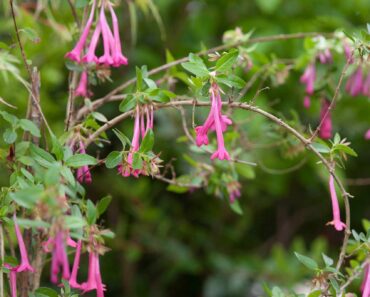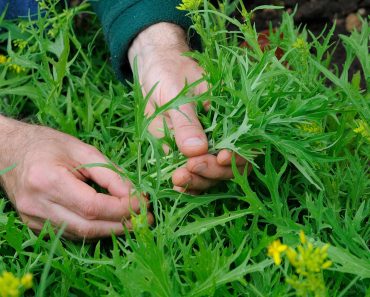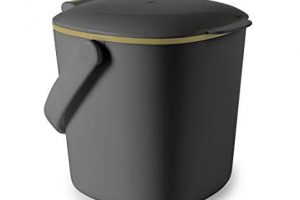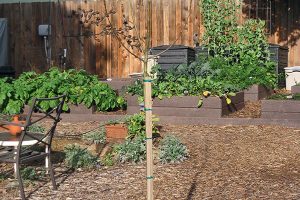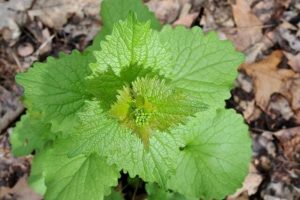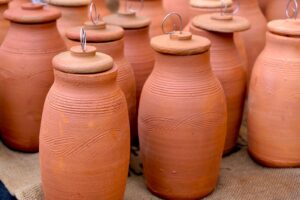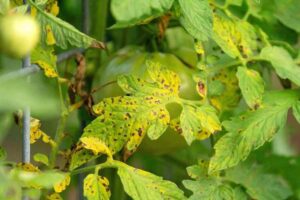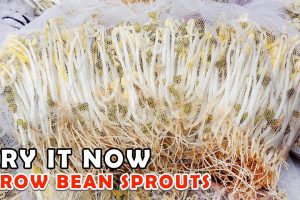Mock orange (philadelphus), is an elegant, classic flowering shrub. It’s long been a garden favourite for its pure white blooms, which are deliciously scented and reminiscent of orange blossom. They appear in late spring and summer against a smart backdrop of dark green, often arching foliage.
Mock orange is sometimes considered to be a one-hit wonder, as it fades into insignificance once the flowers have gone over. But, if you have room, it’s worth including in the garden as its flowers are so abundant and their scent so intoxicating, especially early in the morning and in the evening. The single-flowered varieties also attract bees and butterflies.
Mock oranges look good at the back of a mixed border but also do well in a large container, near a seating area or doorway where you can make the most of the fragrant flowers. Some compact varieties are available for smaller gardens, and plants grow well in pots. Despite their delicate appearance, mock oranges are surprisingly tough, coping well in coastal and exposed areas.
Where to grow mock orange

Mock orange grows best in moist but well-drained soil in full sun or light shade. It looks good at the back of a mixed border. Avoid planting on heavy, wet soils or in heavy shade.
When to plant mock orange
The best time to plant mock orange is in spring or autumn when the ground is warm. This will give the shrub time to establish before summer or winter.
How to plant mock orange

If planting in the border, gig a generous hole, adding a spadeful of well-rotted compost and a sprinkling of mycorrhizal fungi. Plant so that the top of the rootball is level with the surrounding soil. Back fill the hole, firm the soil and water in well. Mulch with organic matter such as garden compost or well rotted manure to help retain moisture.
Smaller varieties such as ‘Petite Perfume Pink’, which only reaches 1.2m tall, can be planted in pots. Fill a large container with a soil-based compost and plant with the rootball level with the top of the compost. Firm in well and water.
How to care for mock orange
Water philadelphus regularly until established and during dry spells for a couple of years. After that, it should get enough moisture from rainfall.
Mulch around shrubs in the spring, with a thick layer of compost or well-rotted manure.
Most philadelphus are hardy and don’t need extra care over winter.
How to prune mock orange

To keep mock orange shrubs in shape, cut back the shoots after flowering, down to a strong bud. Thin out any stems that are weak, overcrowded or crossing and a few from the centre of the shrub to ensure there’s good air circulation around the plant. Leave at least eight strong, well spaced young stems to carry next spring’s flowers. Prune back the taller, older stems by about a third, cutting just above a strong sideshoot.
To prune an old shrub, cut out three or four of the thickest stems at the base, to encourage new ones to grow. Do this annually to get a succession of flowering stems. Flowers appear on stems from the previous season’s growth, so if you have to hard prune an older, established philadelphus, be prepared to lose out on some flowers for a year or so while it recovers.
How to propagate mock orange
Mock orange shrubs can be propagated by softwood cuttings in the summer or hardwood cuttings from mid-autumn to late winter.
Take softwood cuttings between March and August from strong new shoots.
- Cut off a long shoot just above a leaf. Reduce this shoot to a 10cm cutting, cutting below a leaf joint or node.
- Remove leaves from the bottom of the cutting.
- Make a hole in a 7cm pot of compost using a pencil or a dibber and insert the cutting.
- Cover the pot with a plastic bag until the cutting has rooted.
Take hardwood cuttings between November and February.
- Cut a long pencil-thick shoot from your shrub, making a horizontal cut just above a leaf joint or bud.
- Remove the shoot tip just above a bud, then trim the bottom of the cutting, just below another bud, to create a cutting that is about 20cm long.
- Insert the cutting so that it’s 10cm deep, in a pot of loam-based cuttings compost.
- Overwinter in a coldframe and keep the cuttings watered until shoots appear in the spring. Leave 12 months before transplanting your cuttings.
Pests and diseases
Philadelphus can be prone to aphids, which can make the leaves curl, but no other significant pests. Encourage wildlife into your garden to keep pests such as aphids at low levels. Aphids predators include ladybirds, earwigs and birds, such as blue tits. You can also squash aphids by hand or wash off by spraying the plant with a hose.
Keep well watered in dry periods to avoid powdery mildew.
Advice on buying mock orange (philadelphus)
- This shrub is sold under the name mock orange and its botanical name, philadelphus
- Check the final size of the shrub before buying to make sure it’s suitable for your garden
- Always check plants for signs of damage or disease before planting
Where to buy philadelphus
Varieties of mock orange to grow

Philadelphus ‘Virginal’ – beautiful, double flowers with a beautiful scent. Height x Spread: 3m x 2.5m
- Buy Philadelphus ‘Virginal’ from Marshalls
Philadelphus ‘Manteau d’Hermine’ – a compact variety with double, pompon-like flowers. H x S: 75cm x 1.5m
- Buy Philadelphus ‘Manteau d’Hermine’ from Thompson & Morgan
Philadelphus ‘White Rock’ (RHS AGM) – an upright shrub with cascading stems of fragrant, semi-double blooms. It’s well suited to growing in a large container. H x S: 3m x 2.5m
- Buy Philadelphus ‘White Rock’ from Larch Cottage
Philadelphus ‘Lemoinei’ – an unusual variety with pale green leaves and white flowers that have a yellow centre. H x S: 1.5m x 1.5m
- Buy Philadelphus ‘Lemoinei’ from Thompson & Morgan
Philadelphus ‘Belle Etoile’ – a popular choice, this is a compact philadelphus with single white flowers with purple centres, appearing in late spring and early summer. H x S: 1.2m x 2.5m
- Buy Philadelphus ‘Belle Etoile’ from Thompson & Morgan
Philadelphus coronarius ‘Aureus’ – the foliage of this philadelphus is a limey-golden green when young, giving it an added zing. Flowers are white and scented. Needs shelter from strong sun. H x S: 2m x 2.5m
- Buy Philadelphus coronarius ‘Aureus’ from Suttons
Philadelphus ‘Snowbelle’ has double white flowers which are bowl-shaped and highly scented. H x S: 1.2m x 1.2m.
- Buy Philadelphus ‘Snowbelle’ from Thompson & Morgan
Frequently asked questions
Do philadelphus lose their leaves in winter?
Yes, mock orange shrubs are deciduous and will drop their leaves in the autumn.
Are philadelphus toxic to pets?
Philadelphus is not considered toxic to cats or dogs.

